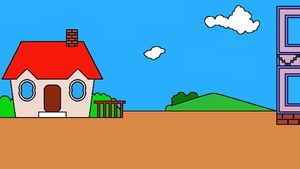Pac-Land
| Pac-Land | |
|---|---|
 File:PacManSymbol.png The beginning of the stage. | |
| Universe | Pac-Man |
| Appears in | SSB4 (Wii U) |
| Availability | Unlockable |
| Unlock criteria | Play all 3 maps in Smash Tour |
| Maximum players | 6 8 (Ω form only) |
| Tracks available | PAC-MAN'S PARK / BLOCK TOWN PAC-MAN PAC-MAN (Club Mix) Namco Arcade '80s Retro Medley 1 Namco Arcade '80s Retro Medley 2 Libble Rabble Retro Medley Sky Kid Retro Medley Metro-Cross Retro Medley Yokai Dochuki Retro Medley Bravoman Retro Medley |
| Article on Wikipedia | Pac-Land |
Pac-Land (パックランド, Pac-Land), also stylized PAC-LAND, is a stage that appears exclusively in Super Smash Bros. for Wii U.
Layout
Similar to Mushroomy Kingdom from Brawl and 3D Land from the 3DS version, it is a side scrolling stage. The stage follows the layout of the original Pac-Land game, traveling through the town level, the bridge level, the mountain level, and ending at the fairy world (which was just a goal in the original game). After this, the stage scrolls back to the left, mimicking Pac-Man's return trip in the original game as well. The stage also causes players to become flat (similar to the Flat Zone stages). After the first two sections of the trip, a break time sign appears and a sign appears that shows a point score that is dependant on the height of a certain area, as well as in fairy land and by Pac-Man's house on the return trip.
Every time a cycle starts, a screen similar to the original appears that states Trip # (the number being the same as how many cycles have started). Unlike the original Pac-Land, the cycles are the same, although the color of the sky is dependant on the trip (1, 5, etc. is afternoon, 2, 6, etc. is evening, 3, 7 etc. is night, 4, 8, etc is early morning)
The Stage starts at Pac-Man's House and scrolls on through a town where buildings can be used as platforms. Fire hydrants appear throughout the stage and shoot water that pushes players back. One can be pushed similar that, once pushed, makes the player grow as if touching a Super Mushroom. The second section is a forest where players are silouettes behind the tress. Several tree trunks appear that require jumps. The third section is a bridge that is made of several platforms above water (which players cannot swim in). A model ship appears and can add extra platforms. The stage transitions to Fairy Land and a trip back begins. It starts with several cacti that are stacked upon each other. Hitting a certain point gains a special floating item that acts as a Super Star. It then transitions into several mountains and a lake. The town follows thereafter and pushing a certain hydrant releases balloons that can heal damage when touched. The stage ends at Pac-Man's house and starts again.
The mountain level serves as the Omega version of this stage. Despite having walls, wall jumps are impossible here.
Origin
The stage is based on the arcade game Pac-Land. The game was a side-scroller where one would go through three levels to bring a fairy to its home, then go through a level incorporating elements of those three levels in the opposite direction to get home.
The game is notable for being one of the first to use parallax scrolling (where the foreground and background move at different speeds to simulate perspective), long before it became a gaming mainstay in the 16-bit era. This is reflected by the parallax scrolling on the stage.
It is also the first game to feature the more anthropomorphic design of Pac-Man in-game. The version published by Midway Games in the United States featured the character designs from the Hanna-Barbera Pac-Man cartoon.
Pac-Land was later used in future Pac-Man games, but with different designs. Its most notable modern appearance is in Pac-Man World 2.
Gallery
Pac-Man, Toon Link, Yoshi, and Male Wii Fit Trainer in Fairy Land.
Rosalina next to the Fairy Queen.
- Pac-LandΩ.jpg
|
| |
|---|---|
| Fighter | Pac-Man (SSB4 · SSBU) |
| Assist Trophy | Ghosts |
| Stages | Pac-Maze · Pac-Land |
| Trophies and Spirits | Trophies · Spirits |
| Music | SSB4 · Ultimate |
| Masterpiece | Pac-Man |





